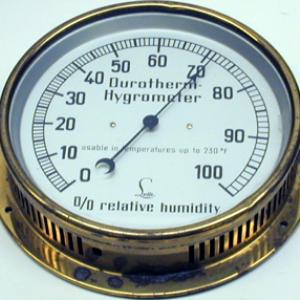College of Liberal Arts & Sciences
4C32.15 - Relative Humidity Indicator - Hygrometer
The meter will give a continuous reading of the relative humidity present in the lecture rooms.
- Larry Silva, and Daniel Beiting, "What Does a Pine Cone Tell Us About Humidity?", TPT, Vol. 37, # 1, Jan. 1999, p. 48.
- Larry Silva, "More on Pine-Cone Behavior", TPT, Vol. 37, # 2, Feb. 1999, p. 67.
- Manfred Bucher, "Diagram for Relative Humidity", TPT, Vol. 24, # 6, p. 348, September 1986.
- Jay S. Huebner, "A Human Hair Hygrometer", TPT, Vol. 11, # 3, March 1973, p. 180.
- Thomas B. Greenslade, Jr., "Hair Hygrometer", AJP, Vol. 92, #11, Nov. 2024, p. 863.
- K. Tennakone, "Construction of an Electrical Humidity Sensor from Silica Gel," AJP, 53, # 10, October 1985.
- George M. Hopkins, "Hygrometry", Experimental Science, p. 196.
- A. D. Bulman, "Hygrometers", Model-Making for Physics, p. 29.
- Shawn Carlson, "Waiter, There's a Hair in my Hygrometer", The Amateur Scientist, June 1998.
- Albert G. Ingalls, "About a Hygrometer made From a Flower Pot, and Huge Telescopes with Compound Mirrors", The Amateur Scientist, May 1954.
- Julius Sumner Miller, Q118 & A118, Millergrams II – Some More Enchanting Questions for Enquiring Minds, p. 14 & 77.
Disclaimer: These demonstrations are provided only for illustrative use by persons affiliated with The University of Iowa and only under the direction of a trained instructor or physicist. The University of Iowa is not responsible for demonstrations performed by those using their own equipment or who choose to use this reference material for their own purpose. The demonstrations included here are within the public domain and can be found in materials contained in libraries, bookstores, and through electronic sources. Performing all or any portion of any of these demonstrations, with or without revisions not depicted here entails inherent risks. These risks include, without limitation, bodily injury (and possibly death), including risks to health that may be temporary or permanent and that may exacerbate a pre-existing medical condition; and property loss or damage. Anyone performing any part of these demonstrations, even with revisions, knowingly and voluntarily assumes all risks associated with them.
